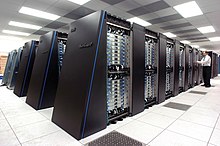
Fortran
General-purpose programming language / From Wikipedia, the free encyclopedia
Dear Wikiwand AI, let's keep it short by simply answering these key questions:
Can you list the top facts and stats about Fortran?
Summarize this article for a 10 years old
Fortran (/ˈfɔːrtræn/; formerly FORTRAN) is a general-purpose, compiled imperative programming language that is especially suited to numeric computation and scientific computing.
| Paradigm | Multi-paradigm: structured, imperative (procedural, object-oriented), generic, array |
|---|---|
| Designed by | John Backus |
| Developer | John Backus and IBM |
| First appeared | 1957; 66 years ago (1957) |
| Stable release | Fortran 2018 (ISO/IEC 1539-1:2018)
/ November 28, 2018; 4 years ago (2018-11-28) |
| Typing discipline | strong, static, manifest |
| Filename extensions | .f90, .f, .for |
| Website | fortran-lang |
| Major implementations | |
| Absoft, Cray, GFortran, G95, IBM XL Fortran, Intel, Hitachi, Lahey/Fujitsu, Numerical Algorithms Group, Open Watcom, PathScale, PGI, Silverfrost, Oracle Solaris Studio, others | |
| Influenced by | |
| Speedcoding | |
| Influenced | |
| ALGOL 58, BASIC, C, Chapel,[1] CMS-2, DOPE, Fortress, PL/I, PACT I, MUMPS, IDL, Ratfor | |
Fortran was originally developed by IBM[2] in the 1950s for scientific and engineering applications, and subsequently came to dominate scientific computing. It has been in use for over seven decades in computationally intensive areas such as numerical weather prediction, finite element analysis, computational fluid dynamics, geophysics, computational physics, crystallography and computational chemistry. It is a popular language for high-performance computing[3] and is used for programs that benchmark and rank the world's fastest supercomputers.[4][5]

Fortran's design was the basis for many other programming languages, especially BASIC and ALGOL. But Fortran has itself evolved through numerous versions and dialects, adding extensions while largely retaining compatibility with preceding versions. Successive versions have added support for structured programming and processing of character-based data (FORTRAN 77), array programming, modular programming and generic programming (Fortran 90), High Performance Fortran (Fortran 95), object-oriented programming (Fortran 2003), concurrent programming (Fortran 2008), and native parallel computing capabilities (Coarray Fortran 2008/2018).

Since August 2021, Fortran has ranked among the top fifteen languages in the TIOBE index, a measure of the popularity of programming languages.[6]